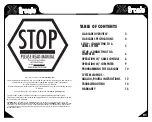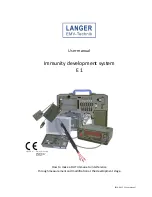
Refrigerating Specialties Division
1
BULLETIN DN23-06
B
A4A Series
January 2007
Installation, and Service Information
ADAPTOMODE
®
INLET
PRESSURE REGULATORS
Types: A4AS-DN, A4AB-DN,
A4AD-DN, A4AZ-DN
PORT SIZE 20 - 100 mm (3/4" - 4")
FOR AMMONIA, R-12, R-22, R-502
OTHER REFRIGERANTS AND OIL
FEATURES
• Pilot operated characterized Modulating Plug for precise
control
• Suitable for all common refrigerants and oil
• 2
8
bar (
406
psig) design pressure (PS)
• Flanges for threaded or welded steel pipe and copper
tube (copper not for ammonia)
• Unique Modular construction
• Interchangeable parts
• Easy to service
• Close coupled strainers, optional
• Stainless Steel Diaphragm
• Stainless Steel Pilot Seat
• Manual Opening Stem
• Complies with Pressure Equipment Directive 97/23/EC
Description:
These compact, heavy duty, pilot operated, Inlet Pressure Regulators
are suitable for Ammonia, R-12, R-22, R-502 and other common
refrigerants and fluids approved for use in refrigeration systems.
All A4 Regulators are pilot operated using upstream pressure for the
opening force and require a minimum 0.14 bar (2 psi) pressure drop
to fully open.
These valves are generally ordered with close coupled upstream
strainer to prevent entrance of foreign material into the valve and the
rest of the system. (See current Bul. DN00-10 for strainer information.)
Purpose
Modulates flow of refrigerant gas or liquid to maintain a constant
upstream (or inlet) pressure as set-for, despite load fluctuations.
The fluid temperature range for the A4 Series of Regulators is -45°C
to 105°C (-50°F to 220°F).
Principles of Operation (See Fig. 1)
The inlet pressure enters the space under the diaphragm through
passage N. When the force created by the pressure exceeds the force
of the range spring, the diaphragm is lifted off the pilot seat allowing
pressure to enter on top of the power piston. This causes the power
piston to move downward forcing the modulating plug to open and
modulate to maintain constant inlet pressure. An increase in inlet
pressure lifts the diaphragm further, allowing more pressure on top of
the power piston and opening the valve wider. A decrease in inlet
pressure causes the diaphragm to move closer to the pilot seat
reducing the pressure on the top of the power piston and causing the
closing spring to reduce the valve opening. The pressure on top of the
power piston is controlled by the flow through the pilot seat and the
bleed off through the bleed hole in the power piston and through the
clearance between the piston and cylinder. A minimum of 0.14 bar (2
psi) pressure drop across the valve is required to open it fully.
The A4A Inlet Pressure Regulator therefore opens on a rise in the
inlet pressure above its set point and closes on a drop in inlet pressure
below its set point. The inlet pressure set point is not appreciably
affected by variations in the outlet pressure.
Manual Opening Stem
All Type A4A Regulators are provided with a manual opening stem. To
open the regulator manually, back the stem out (turn counter-clockwise)
until it stops. To put the regulator into automatic operation, turn the
stem in (clockwise) until only the flats on the stem protrude from the
packing nut.
I S O 9 0 0 1 C E R T I F I E D
A4AZ
Fig. 1
A4AS-DN
A4AD-DN
A4AZ-DN
A4AB-DN
310214



























